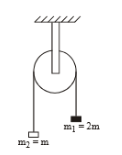The moment of inertia of pulley is I and its radius is R. The string doesn't slips on the pulley, as system is released, the acceleration of the system is
 \(\)
\(\)
1.
2.
3.
4.
 \(\)
\(\)
In uniform circular motion
1. Both the angular velocity and the angular momentum vary
2. The angular velocity varies but the angular momentum remains constant
3. Both the angular velocity and the angular momentum stay constant
4. The angular momentum varies but the angular velocity remains constant
A force of 50 dynes is acted on a body of mass 5 g which acts for an interval of 3 seconds, then impulse is
1. 0.15 × 10–3 N-s
2. 0.98 × 10–3 N-s
3. 1.5 × 10–3 N-s
4. 2.5 × 10–3 N-s


1. \(\frac{3g}{2L}\)
2. \(\frac{3g}{\sqrt{2}L}\)
3. \(\frac{3g}{2\sqrt{2}L}\)
4. \(\frac{6g}{\sqrt{2}L}\)
A body of mass m slides down an incline and reaches the bottom with a velocity v. If the same mass were in the form of a ring which rolls down this incline, the velocity of the ring at bottom would have been
1. v
2.
3.
4.
A body of mass (m) is projected with velocity v0 at an angle of projection . The magnitude of angular momentum about origin after time t from projection is :
1. Increase with time
2. decrease with time
3. independent of time
4. none of these
If no external force acts on the system, then the correct statement is:
1. velocity of the centre of mass changes.
2. momentum of the centre of mass is conserved and constant.
3. position of the centre of mass changes with time.
4. None of these.
In an explosion a body breaks up into two pieces of unequal masses. In this
(1) Both parts will have numerically equal momentum
(2) Lighter part will have more momentum
(3) Heavier part will have more momentum
(4) Both parts will have equal kinetic energy
Two bodies of masses m1 and m2 have equal kinetic energies. If p1 and p2 are their respective momentum, then ratio p1 : p2 is equal to
(1)
(2)
(3)
(4)
A light and a heavy body have equal momenta. Which one has greater K.E
(1) The light body
(2) The heavy body
(3) The K.E. are equal
(4) Data is incomplete






